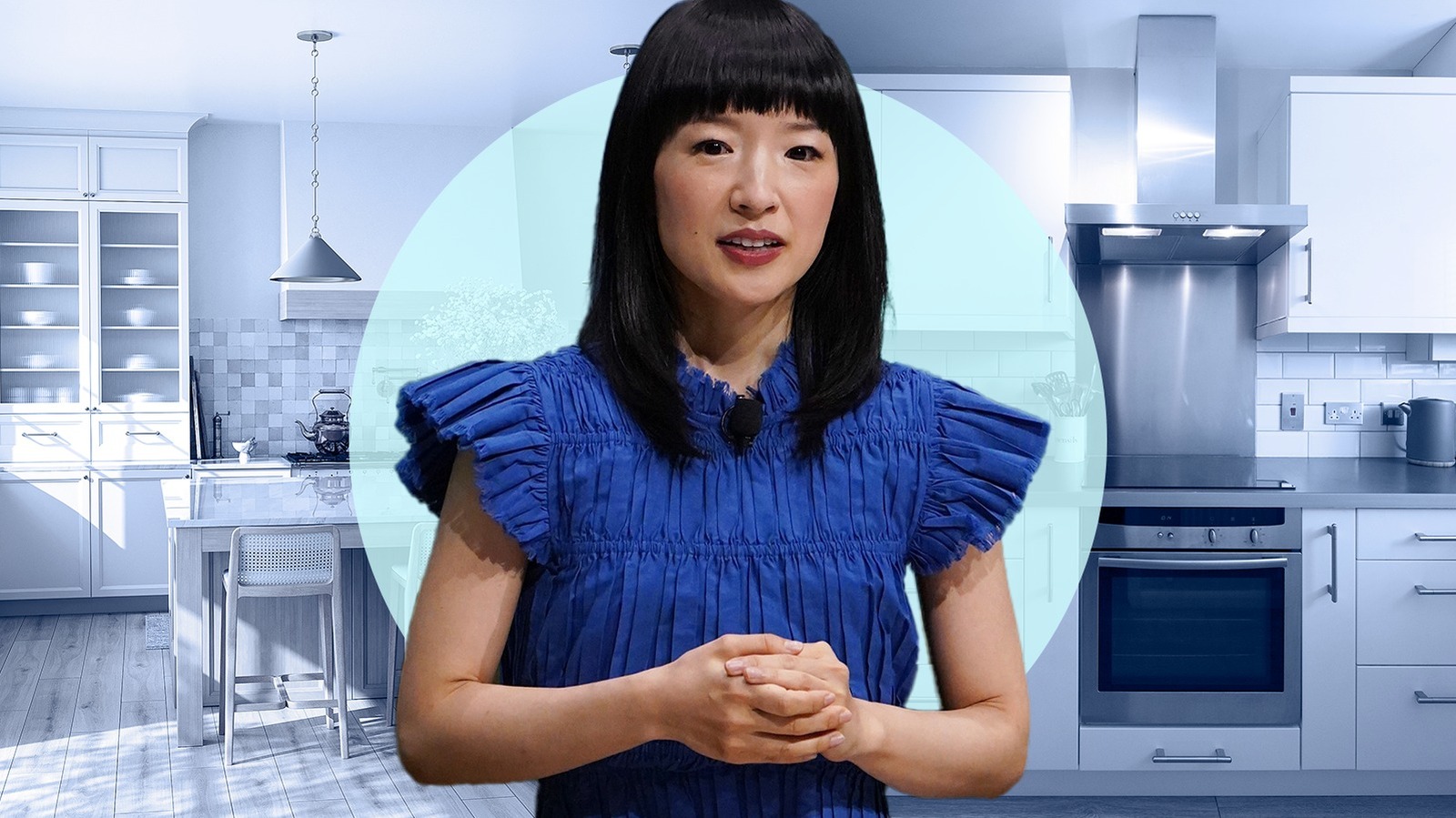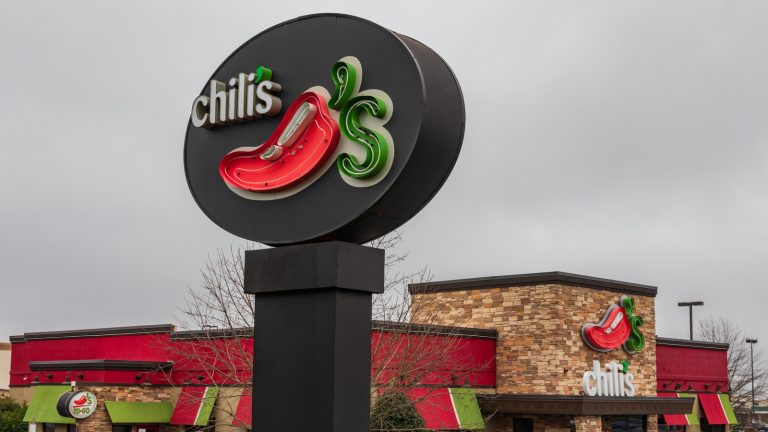We may receive a commission on purchases made from links.
Marie Kondo may have found global fame as a tidying guru, but with tidying and cleaning so clearly interlinked, we can’t think of a better person to look to for tips on getting and keeping your kitchen clean. Kondo once wrote in her book “Spark Joy,” “Tidying is the act of confronting yourself — cleaning is the act of confronting dirt. If you don’t tidy properly, your home will never be properly clean; you are simply moving dirt around.”
Kondo named her tidying philosophy the KonMari method. It’s the term she gave to her guiding principles, which center around deciding what to keep and what to discard by asking the fundamental question, “Does this spark joy?” You can use Kondo’s tips on tidying to create an immaculate and functional space that is easy to keep clean and enjoyable to spend time in.
Before you begin, we suggest you take a moment to appreciate the emotional toil your investment in decluttering and cleaning your kitchen may have. The KonMari method challenges you to throw out anything that isn’t essential, even items that may have sentimental value. Letting go of items can be hard, but it is necessary on the path to your dream of a clean, serene kitchen space.
Let’s not forget that Kondo’s KonMari method is aspirational, and because of space and financial restrictions, some of her ‘goals’ may seem hard to achieve, but our tips for mastering the KonMari method will work for those on a budget or with limited space.
Imagine your ideal kitchen
Every great idea starts with a vision. We recommend starting your kitchen cleaning by focusing on the end. Take a step back and look at your kitchen. Don’t think about where things are now; think about designing your dream kitchen. Anything you see that is not permanently fixed could be changed; decor can be removed, and appliances can be relocated. Visualize your dream kitchen in the space you have.
Did you know that clutter has been shown to increase stress levels? By mentally beginning your kitchen clean with a blank sheet, you free your mind from the stress surrounding how the kitchen looks now. The simple act of manifesting how you want your kitchen to appear when finished is an important step toward your end goal.
How about sketching your ideas onto paper or writing them down in a notebook? You could even make a mood or vision board for how you want your space to look when it’s clean. While Marie Kondo promotes minimalism, we suggest you consider what your ideal kitchen looks like. Would you like a minimalist kitchen with nothing on the countertops, or are you happy with a busier aesthetic? A vintage, boho, or farmhouse style allows for more items on display.
Kondo famously advocates asking yourself, “Does this spark joy?” In the KonMari method, this phrase is used to determine what items to keep and what to throw. It is also a useful question to raise when visualizing your kitchen. The end result should bring pleasure, whatever form that takes for you.
Prepare mentally and gather all the cleaning essentials beforehand
The pre-planning and preparation stage can be divided into two parts: mental and physical. Marie Kondo tells us to clean by imagining how we want our lives to look.
According to Kondo, a thorough, deep clean of your home is more than just washing dishes; it’s about confronting your attachment to objects and spending time in your head. The KonMari method is about only keeping items around that bring you happiness, or a feeling of joy. This process of cleaning and tidying can be emotional, as seen in her book “The Life-Changing Magic of Tidying: A Simple, Effective Way to Banish Clutter Forever.” In it, Kondo writes, “A dramatic reorganization of the home causes correspondingly dramatic changes in lifestyle and perspective.” Our top tip for cleaning your kitchen the KonMari way is to make sure you mentally prepare yourself for the changes that will take place, and commit to the process.
It’s also important to physically prepare for the challenge. Since cleaning your kitchen can be a lengthy process that can take a few hours to a few days, the prep work beforehand is essential and should include making sure that you have everything you need. Is there anything more annoying than starting a massive project to find out you’re missing an essential item? So, we recommend you arm yourself with garbage bags (for unwanted items), cardboard boxes (for donating items), and any cleaning essentials and tools you may need for the big clean.
Gather all the items in the kitchen into one spot
Remember that mood board — now is the time to put it into action. Marie Kondo advises gathering everything into one area on your floor. We advise completely stripping the kitchen so that nothing is in it. This makes it easier to clean and prepare for the next stage — decluttering and discarding. Removing all items from your kitchen gives you that all-important blank slate. It removes the temptation to put the kettle next to the oven because that’s where it always lives, and it lets you move on with your vision.
A top tip for this stage is to put things in order so that Kondo’s other tip of categorizing your items will be easier to do later. Arrange them in logical order rather than throwing them into one chaotic pile. You could even grab a bunch of boxes and place items in each — appliances, such as your kettle, toaster, and waffle maker, can go in one box, utensils in another, and food in another.
We recommend clearing your refrigerator first or last. You don’t want your food defrosting while you’re cleaning the oven. Remember, when removing food, you must ensure it is stored in a suitable place. If you are taking frozen food, make sure you have another freezer or a well-packed cooler to keep everything cold enough during the time you are cleaning.
Declutter by asking yourself if it sparks joy
Decluttering is the essence of the KonMari method. Much of Marie Kondo’s philosophy asks you to consider if the items are essential and if they bring you joy. Her second book, “Spark Joy,” is named after this philosophy. Did you know that the average American spends around 1,000 hours a year in the kitchen? With so much time spent in one place, Kondo’s philosophy rings true — the kitchen, indeed, all areas within your home, should be pleasurable to spend time in.
You have already started the decluttering stage when you removed your items from the kitchen. This is an important step – Kondo believes that having all your belongings in one place helps us understand how much we own. With this holistic view, now is the time to trawl through all those dusty and unloved belongings and ask yourself if you need them. Look at how many single-use items you have: the apple cores, banana choppers, or garlic press.
Take a look at duplicates — no one needs five spatulas. Forgo the everyday plates and use your best china. One might find it difficult to get too worked up about everyday kitchen items, but the idea is to choose the ones that bring you the most joy, the spatula you pick every time you reach into your utensil drawer. Remember that usefulness can also be a kind of joy. While basic but essential kitchen appliances may not thrill, there will probably be a subtle favorite — the trick is narrowing it down.
Discard immediately
Marie Kondo tells us that tidying involves only two main tasks – discarding and deciding where to keep things. For many, discarding items may be the hardest task. The KonMari method asks you only to keep items that inspire feelings of happiness. Kondo encourages us to hold each item in our hands and ask ourselves if it sparks joy. Kondo describes it as “… a little thrill, as if the cells in your body are slowly rising. This aspirational thought may prove more challenging than you realize — requiring you to be mercenary in your actions; even discarding sentimental items if their presence doesn’t bring you a feeling of warmth and happiness.
The discarding step in the KonMari method is vital. In fact, Kondo advises not starting to put away or clean until you have finished discarding. Additionally, you should discard your things all at once. Kondo rationalizes this by saying that you will never finish if you interrupt the discarding process by putting items away or organizing them. She believes that keeping even a small amount of unnecessary clutter is the first step in letting it accumulate again. Once you’ve freed yourself from the burden of unneeded items, you will have a true sense of what to organize, store, and clean.
Kondo reminds us to be mindful when discarding items and to always have sustainability in mind. Kondo urges followers to rehome, resell, donate, or recycle unwanted items, taking particular care to dispose of items appropriately, avoiding landfill or introducing dangerous chemicals into the environment.
Start with the big items — and don’t forget the fridge
Start by cleaning the big-ticket items: the fridge, freezer, dishwasher, oven, and any other large appliances you have. Begin by moving them out of the way if you are able to, and sweep and clean behind them –– then, wipe down the outside. Give the microwave, oven, and other large appliances a deep clean, and run the dishwasher through a cleaning cycle. Now it’s time to tackle the fridge.
When cleaning your refrigerator, Marie Kondo recommends removing all items if you want to clean the shelves. While doing this, look through your fridge contents for expired items — throw out old leftovers after a few days, and check the sell-by dates on longer-life items like salad dressings and condiments. The KonMari method suggests you perform a joy check, take a moment to consider the food in your fridge, and ask yourself what sparks joy. Kondo says this is the moment to consider the lifestyle you aspire to have, rather than perhaps the one you currently have. Kondo encourages you to throw out or donate foods that don’t support your lifestyle goals.
When organizing your fridge, Kondo follows a 70/30 rule. She states that an overfilled fridge is cluttered, prevents you from seeing all the food, and simplifies storing leftovers. The best way to store food in your fridge is to store like with like and use containers to use up vertical space. Stacking the tallest items at the back and the smaller items at the front.
Sort by category not location
Once you’re ready to organize the kitchen, a Marie Kondo tip is to sort by category, not location. Group them into things you cook with, things you eat with, food and food storage, and cleaning supplies.
We suggest taking this a step further and adding subcategories. So, within the things you cook with, separate them into appliances, saucepans, frying pans, cooking utensils, like spatulas, and preparation utensils, like kitchen knives, vegetable scrapers, corkscrews, and lime zesters. Kondo believes that the act of removing all items from the kitchen and putting them in one place helps to give us an understanding of how much we own. Hands up anyone with five different spatulas, eight similar-sized saucepans, and whole piles of out-of-date cans of beans.
These subcategories can also be useful if you are struggling with space. You may be surprised at how much stuff is in your kitchen when you spread it all out on the living room floor. Kondo recommends that you sort by one category at a time, and sorting each subcategory, in turn, is also helpful if you are overwhelmed by the task. Small bite-sized chunks are easier to manage than one huge pile of kitchen items.
Focus on food
Food may not spring to mind when you think about cleaning your kitchen, but food may be the messiest thing there: onion peelings, dripping bottles, scattered cereals, and breadcrumbs. Marie Kondo has clear directions when it comes to storing and organizing food.
First, she advises you to take a good look at your cupboard goods. Start by throwing out anything that is out of date. Then, unsurprisingly, it involves asking yourself if this food brings you joy. If it doesn’t, it’s time to get rid of that packet of quinoa or can of borlotti beans that you haven’t bothered eating yet. Rather than throwing perfectly good food items in the garbage, why not donate them to a food bank, where they will be used to feed people in need?
Once you have narrowed your food down, Kondo advises storing it all in one place. We are mindful that not everyone has the luxury of a walk-in pantry, so if you don’t have a cupboard large enough to store all of your store cupboard food items, try to store them by category, dedicating a cupboard to similar food categories, such as dry carbs and lentils.
Food can be divided into categories as follows: dry carbohydrates (rice, pasta, couscous, quinoa, chia seeds, oats), canned and jarred goods (beans, tomatoes, coconut milk, jams), legumes and pulses (lentils, dried peas and beans), flours and baking (flour, yeast, sugar, cocoa powder), oils and condiments, herbs and spices, dried foods (fruit, nuts, cereals), snacks (chips, cookies). Don’t forget to apply these organizational principles to the fridge. Check out this article for tips on cleaning your fridge with the KonMari method.
Space glorious space
According to Marie Kondo, every item in your kitchen should have a home, and each space should be a functional zone. Again, we are looking at categories, such as food, tools (things you use to cook), cookware (things you cook in like pots, pans, bakeware), tableware (bowls, plates, cutlery, cups), cleaning supplies, and miscellaneous item (known as komono in Japanese) like Tupperware, foil, saran wrap, and thermoses.
Each category should be allocated a space, that is, a cupboard or shelf, and consideration should be given to how they are placed in there. Kondo advises storing vertically. Here’s our tip: Don’t balance all those plates in a precarious pile; instead, utilize space-saving devices to make storage and access easier. Look at internal shelving, plate stackers, pot holders, and classic trays like lazy susans that slot into your fridge or cupboards. Consider using baskets on shelves in the kitchen for storage. Decant food items from their packets and place them into clear storage containers.
The aim is to keep your counter free of clutter; it’s entirely up to you how clear you want it to be, but think back to your initial vision board. Some people may prefer to store everyday kitchen appliances like the kettle or toaster in a specific cupboard, or you may have those on the counter so they are easy to hand. When considering placement, remember those zones; can you create a hot drinks zone where the kettle, coffee maker, and cups all sit together? Place a shelf above your cooker, and place pots and pans on it, making them easier to access and clean.
Form the habit of cleaning daily
Here’s the kicker. Cleaning your kitchen is not a one-off. The KonMari method is more than a deep clean; it is a commitment to a way of life. By cleaning your kitchen of all clutter and only keeping items with a specific and essential function or deep meaning, you have allowed yourself the space to keep things clean, but the task is ongoing.
It starts with a commitment to keeping it clean and tidy, and the easiest way to make this happen is to do this as you go along. You’ve done the deep clean, but as Marie Kondo says, regular daily cleaning takes care of highly trafficked areas. Rather than letting dishes pile up, wash or place them in a dishwasher as you go. Discard vegetable peelings as you cook, wipe down counters while the rice boils, and wipe the walls as your tea brews. By cleaning as you go, you break down a huge task into small, manageable bites. You’ve already done the hard work; don’t let your kitchen mess build up until sorting it out becomes a gargantuan task again.
It takes around two months to form a habit; if you have a family, make sure they commit to the task too. Even young children can be taught to place their dishes in a dishwasher, bring their plates to the sink, and throw garbage directly in the can. In two months, these small actions, which can make a huge difference to keeping your kitchen clean, will become second nature.





